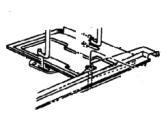
My Garage
My Account
Cart
Genuine Dodge Ramcharger Car Batteries
Auto Battery- Select Vehicle by Model
- Select Vehicle by VIN
Select Vehicle by Model
orMake
Model
Year
Select Vehicle by VIN
For the most accurate results, select vehicle by your VIN (Vehicle Identification Number).
2 Car Batteries found
Dodge Ramcharger Terminal-Battery Terminal
Part Number: VU01205$58.28 MSRP: $86.60You Save: $28.32 (33%)
Dodge Ramcharger Car Batteries
The Car Batteries of Dodge Ramcharger vehicles plays an Electrochemical role whereby it furnishes electrical current needed to start the ignition as well as to power ignition and fuel injection systems. It also serves the radio parts should the engine be off and is also functional all the time the car is not in use. Dodge Ramcharger for the years it has been in production has employed categories of batteries such as conventional flooded lead-acid, FLA maintenance-free, and AGM batteries. A main disadvantage of FLA batteries is that they need some sort of maintenance, whereas some of the benefits of using AGM batteries include no maintenance needed, shock proof and better performance off-road. Decisions regarding Car Batteries selection affect some aspects such as service life, maintenance and the general reliability of any Car Batteries hence the need for selection of the most appropriate Car Batteries.
Looking for affordable and high-quality auto parts? Then you have already arrived at the proper online shop. We offer all Dodge Ramcharger Car Batteries at great affordable prices. Moreover, all genuine Dodge Ramcharger Car Batteries come with a manufacturer's warranty. In the long run, you would realize you have saved a lot of trouble and money with OEM parts from here.
Dodge Ramcharger Car Batteries Parts Questions & Experts Answers
- Q: What precautions should be followed when checking a battery on Dodge Ramcharger?A:Some safety measures must be observed when inspecting or recharging the battery because hydrogen gas contained in the battery cells is highly flammable; thus, it is prohibited to smoke, use any opening flames or sparks near the battery. The electrolyte solution used inside the battery is dilute sulfuric acid; this strongly corrodes skin and eyes, and bleaches clothes and any painted surface. Personal protective equipment that should be worn when attending to the batteries include gloves, goggles or nose mask; for the actual maintenance process, items needed are baking soda, a stick of petroleum jelly, battery cable puller, cleaning tools for both cables and terminal post, and a hydrometer. First of the battery should be inspected for crack and leakage, all vent caps should be removed to check the level of the electrolyte solution and add distilled water if is low but it should not be overfilled. On a case to case basis take a hydrometer reading of the electrolyte solution and correct it where necessary particularly when in a freezing environment the reading is usually low and recharge the battery. Check the battery cable clamps are closed and not rusty, if they are, then remove the rust and use petroleum jelly or grease to prevent rusting in future. Check cables of battery for signs of wear and tear and oversheath of the positive terminal is present and in good condition. The battery should be fastened down to prevent it from coming loose, but not over torqued while the case and caps should be clean and dry. If the car will not be driven for a long time it is advisable to remove the battery cables and recharge the battery about once every six weeks. Corrosion on hold-down components and inner fender panels can be effectively rinsed with water mixed with baking soda while on the battery case and terminals, special cautious has to be taken not to come into contact with the battery cells. If metal items are exposed due to leakage of battery acid they should be painted with zinc-based paint and primer after washing. If specific gravity is low, then give battery a recharge but disconnect cables to avoid inflicting damage to the electrical system if charging in the automobile. Charging should not be done near smoke or flames and charging should only be started after connecting all the terminals. It normally takes between 12 and 16 hours to charge and a slow charge is best for the life of the battery. Take off the vent caps and put a clean cloth over the holes in order for the charger terminal to touch the battery terminal and set the charger to 12 volt range. Watch the battery while charging so as not to overcharge, and consider the battery fully charged when it starts gassing vigorously and when its specific gravity readings are constant over three hourly intervals; gassing, overheating and low specific gravity are signs of a bad battery.




